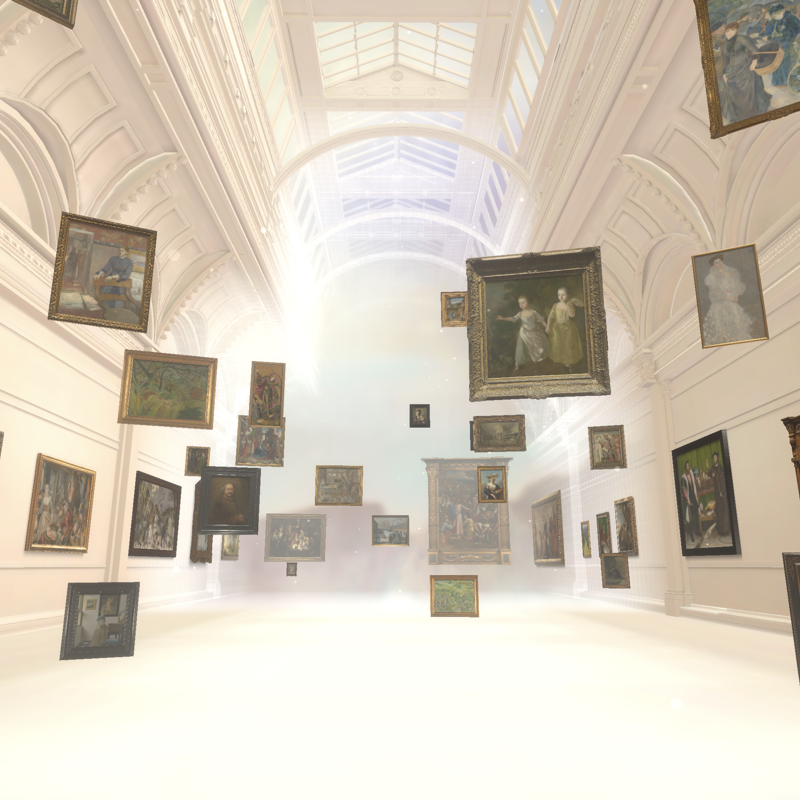Rosa Bonheur, 'The Horse Fair', 1855
About the work
Overview
This is a painting of sheer animal power. Brilliant white light builds up the turbulence and excitement of the scene. Rosa Bonheur has made the convulsion of the muscles and the flying manes almost tangible, capturing the rearing, plunging animals and the strength and dexterity of their handlers with almost photographic reality. The magnificent white horses in the picture are Percherons, bred for hauling weights. Bonheur has captured their spirit and their world, with its noises, smells and sense of danger, and made them into high art.
The original version of The Horse Fair was four times the size of the National Gallery picture, painted when the work of women artists was largely disregarded by critics. It caused a sensation at the 1853 Paris Salon, toured Britain and the US and brought Bonheur international fame. This smaller autograph version was painted to facilitate the making of prints for sale during the tour.
Key facts
Details
- Full title
- The Horse Fair
- Artist
- Rosa Bonheur
- Artist dates
- 1822 - 1899
- Date made
- 1855
- Medium and support
- oil on canvas
- Dimensions
- 120 × 254.6 cm
- Inscription summary
- Signed
- Acquisition credit
- Bequeathed by Jacob Bell, 1859
- Inventory number
- NG621
- Location
- Room 13 Stairs
- Collection
- Main Collection
- Previous owners
- Frame
- 19th-century French Frame (original frame)
Provenance
Additional information
Text extracted from the ‘Provenance’ section of the catalogue entry in Martin Davies, with additions and some revisions by Cecil Gould, ‘National Gallery Catalogues: French School: Early 19th Century, Impressionists, Post-Impressionists, etc.’, London 1970; for further information, see the full catalogue entry.
Exhibition history
-
2022Rosa Bonheur (1822 - 1899)Musée des Beaux-Arts de Bordeaux18 May 2022 - 18 September 2022Musée d'Orsay17 October 2022 - 15 January 2023
Bibliography
-
1857J.S., The Critic Foiled at Rosa Bonheur's Great Horse Fair, n.p. 1857
-
1857'The Picture of "The Horse Fair" by Rosa Bonheur Now Exhibiting in Bond Street', Art Journal, 1857
-
1859'The Marylebone Literary Institution', Art Journal, 1859
-
1865E. Gambart, 'Letter', The Times, 1865
-
1889R. Peyrol, 'Rosa Bonheur', Art Annual, 1889
-
1900L. Roger-Milès, Rosa Bonheur, Paris 1900
-
1904F. Hird, Rosa Bonheur, London 1904
-
1908A. Klumpke, Rosa Bonheur: Sa vie, son oeuvre, Paris 1908
-
1957Martin Davies, National Gallery Catalogues: French School, 2nd edn (revised), London 1957
-
1966C. Sterling and M. Salinger, French Paintings. A Catalogue of the Collection of the Metropolitan Museum of Art, New York 1966
-
1970Davies, Martin, and Cecil Gould, National Gallery Catalogues: French School: Early 19th Century, Impressionists, Post-Impressionists etc., London 1970
-
1975J. Maas, Gambart: Prince of the Victorian Art World, London 1975
-
1976T. Stanton (ed.), Reminiscences of Rosa Bonheur, New York 1976
-
1981D. Ashton, Rosa Bonheur: A Life and a Legend, London 1981
-
1993K. Heise, Bilder aus der neuen und alten Welt: Die Sammlung des Diamantenhändlers Ludwig Nissen (exh. cat. Schleswig-Holsteinisches Landesmuseum, Kloster Cismar, 27 June - 24 October 1993; Nissen-Haus, Nordfriesisches Museum, 7 November 1993 - 7 January 1994), Schleswig 1993
-
1993W. Chadwick, 'The Fine Art of Gentling: Horses, Women and Rosa Bonheur in Victorian England', in K. Adler and M. Pointon (eds), The Body Imaged. The Human Form and Visual Culture since the Renaissance, Cambridge 1993, pp. 89ff
-
2001
C. Baker and T. Henry, The National Gallery: Complete Illustrated Catalogue, London 2001
About this record
If you know more about this painting or have spotted an error, please contact us. Please note that exhibition histories are listed from 2009 onwards. Bibliographies may not be complete; more comprehensive information is available in the National Gallery Library.


